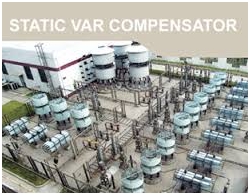Home › Electrical Engineering Forum › General Discussion › Benefits of Static Var Compensators
- This topic has 0 replies, 1 voice, and was last updated 9 years, 11 months ago by
admin.
-
AuthorPosts
-
2014/12/18 at 3:40 pm #11220
admin
KeymasterHere’s an article sent by one of our members Marvin M. It is about benefits of static var compensators to power transmission and distribution.
IntroductionThe growth of residential and manufacturing industries means more energy demand. At present, almost all aspects of our lives, directly or indirectly depend on electricity. Unfortunately, power generation and transmission systems do not come up as fast. This is due to the high installation costs, as well as the growing environmental concerns. The ideal option now is to make the existing systems more efficient and economical to use.
One of the easiest ways is secondary installation of equipment primarily geared to achieve the two elements. One of the most effective additions is the Static Var Compensators. SVCs provide fast acting reactive power as needed to a system. This article highlights the benefits accorded by the SVC.
[caption id="attachment_8753" align="aligncenter" width="250"]
Fig 1:Complete SVC System Installation[/caption]
Power Transmission Benefits
Voltage instability plagues weak systems. A fault in the grid results to hazardous voltage depressions. Induction motors and generators are in widespread use in power transmission companies, as well as industries. The voltage depressions tend to stress the grid system, especially in industrial districts. This often results to equipment damage and frequent power disruption.
The SVC unit serves to absorb the temporary overvoltage that mark weak systems, thus ensure voltage control. This is especially important for systems that require a balanced voltage supply, such as high-speed trains.
One of the banes associated with heavy power flow is the drop in system voltage. This often requires that the transmission company supply more power over the existing lines to meet the demand. A rightly placed SVC unit boosts transmission capacity.
The primary benefit of such a measure is that it allows for easy upgrading of existing lines. For example, a boost in power generation is easily accommodated over the existing lines through installation of SVCs.
Power Oscillation Damping
Power oscillations are a phenomenon that occurs where there is interconnection of heavy equipment such as rotating power generators in a weak system. The primary detriment of power oscillations is the reduction of the power transmission capability. The ideal solution is to damp, or alleviate altogether these oscillations to increase the transmission capabilities in the existing line.
A SVC compensators offers dynamic control over the system by maintaining the upward voltage during the upwards power portions, as well as accelerating the rotating machine during the downward rotation by decreasing system voltage at the SVC.
For the distribution, the benefits are as follows:
- Stabilized voltage, especially for long lines means better power delivery to the consumers. A stable voltage is especially important for large industries with a large number of inductive and capacitive equipment. In the same vein, stabilised loads means reduced losses, as well as reduced stresses on any rotating machinery such as generators and motors.
- SVCs significantly reduce the amount of reactive power in the system. This leads to lower power losses. In the distribution, it can also mean lower tariffs for the consumers as the savings are transferred to the consumers.
[caption id="attachment_8759" align="aligncenter" width="590"]
Fig.2. Static VAR Compensator[/caption]
Conclusion
It is evident that SVCs are important when it comes to power transmission and distribution, especially for existing lines. There are two main types of SVCs’ direct and relocatable systems. The former is usually permanent, and is placed usually at the area with the highest voltage drop or oscillations. It does not require a step down transformer between the SVC unit and the power system.
The primary benefits of a directly connected system are the simplified design, saving on hardware and transport cost and easy expandability. A relocatable SVC on the other hand features a mobile design with all the required components onboard. It allows for flexibility and mobile voltage support for areas with the highest need. The primary benefit is the ease of erection, connection, and easy equipment testing before delivery.
Do you agree with this article? Feel free to discuss about it below in the comments section.
-
AuthorPosts
- You must be logged in to reply to this topic.
 Fig 1:Complete SVC System Installation[/caption]
Fig 1:Complete SVC System Installation[/caption] Fig.2. Static VAR Compensator[/caption]
Fig.2. Static VAR Compensator[/caption]